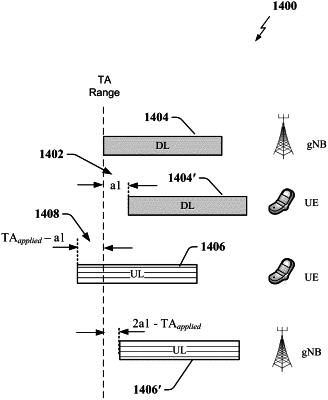| CPC H04W 56/005 (2013.01) [H04L 5/14 (2013.01); H04W 24/10 (2013.01); H04W 74/006 (2013.01); H04W 88/06 (2013.01)] | 28 Claims |

|
1. A method, performed by a base station, for timing alignment of signals in a wireless communication system, the method comprising:
determining a user equipment (UE) in the wireless communication system is operating in a full-duplex (FD) mode with the base station; and
sending a timing advance (TA) indication for the UE,
wherein the TA indication indicates a selection of one of a fixed TA value or a TA value range to be used by the UE while operating in the FD mode, and
wherein an applied TA value to be applied at the UE is configured to be in a range of TA values based on the fixed TA value and a time duration of a cyclic prefix (CP) value used in the wireless communication system, and
wherein the method further comprises:
determining the applied TA value based on the fixed TA value and the time duration of the CP value according to a first relationship: the fixed TA value−CP≤the applied TA value≤the fixed TA value; or
determining the applied TA value based on the fixed TA value, the time duration of the CP value, and a delay (d1) according to a second relationship: the fixed TA value−CP−d1≤the applied TA value≤the fixed TA value−d1, wherein d1 is a self-interference propagation delay associated with a downlink beam and an uplink beam; or
determining the applied TA value based on the fixed TA value, the time duration of the CP value, and a delay spread (DS) of a downlink propagation delay time according to a fourth relationship: the fixed TA value−CP+DS≤the applied TA value≤the fixed TA value; or
determining the applied TA value based on the fixed TA value, the time duration of the CP value, and the delay spread DS of the downlink delay time according to a fourth relationship: the fixed TA value−CP−d1+DS≤the applied TA value≤the fixed TA value−d1, wherein d1 is the self-interference propagation delay associated with the downlink beam and the uplink beam.
|